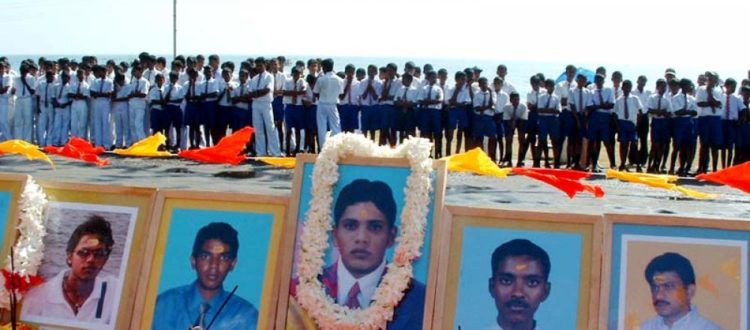Sri Lanka – an emblematic failure in an emblematic case
In the short-term, it is now incumbent on all those members of the international community who have highlighted the case of ‘Trinco Five’ in the past, to continue to support the fight of the surviving family members (whatever direction that fight may now take) – and to ensure that those against whom there are well founded allegations of involvement in the massacre remain in the spotlight until they can one day be brought to book.
| Suggested Reading | Conflict Background | GCCT |
By the Sri Lanka Campaign for Peace and Justice
On 2nd January 2006, a group of Tamil students gathered on the sea front in Trincomalee, a pretty coastal town – and today popular tourist destination – on Sri Lanka’s East coast. Under the gaze of a Mahatma Gandhi statue, the students chatted and ate food together, celebrating the news they had received earlier that day of their admission to university.
Shortly after sunset, five of them were dead; lined up on the roadside and shot, execution-style, by members of Sri Lanka’s security forces. Around fifteen minutes prior to the murders, a grenade had been rolled towards the group from a passing three-wheeler headed in the direction of the army headquarters, injuring several of them. Frantic pleas to get the wounded to hospital were ignored by the authorities. The armed men in uniform who approached the group came not to help, but to eliminate evidence of the crime and those who had witnessed it.

The violence did not end that evening though. As the government’s fabricated version of events – that the students had been LTTE militants readying themselves for an attack on government troops – came under increasing pressure, so too did those willing and able to tell the true story to the world. Among those killed in the ensuing cover-up were:
- Sugirtharajan, a local Tamil journalist whose photos of the dead students, taken at a heavily guarded mortuary, provided irrefutable evidence of the manner of their deaths;
- Balachandran, a taxi-driver who had shared information to relatives of the deceased about the three-wheeler witnessed at the scene of the crime; and
- Handungamuwe Nandarathana, a Buddhist monk who publicly condemned the killings.
Yesterday, the thirteen suspects in the case, including twelve members of Sri Lanka’s Special Task Force (STF) unit, were acquitted of all charges by a local magistrate court.
It is news that will have come as a devastating, if unsurprising, blow to the families of the victims, who – in the face of physical intimidation, death threats, and exile – have fought for over a decade to see that justice is served upon those responsible for the deaths of their loved ones. Among them is Dr Manoharan, the father of murdered Ragihar, who has spoken out courageously and persistently about his son’s case.
This week’s verdict, which is the culmination of a tortuous and faltering thirteen-year effort to convict those responsible in Sri Lanka’s local courts, is one that is all the more shocking when viewed in light of the mass of evidence gathered around the case. Meticulously compiled inquiries by human rights groups have found “overwhelming evidence of state complicity”, while a major UN investigation concluded that there are “reasonable grounds to believe that security force personnel … killed the five students.” In a leaked diplomatic cable from 2006, senior US officials indicated that state complicity in the murders was an accepted fact among Sri Lanka’s leaders. In the words of one leading rights advocate, the massacre “is not such a difficult case.”
The failure to prosecute is also particularly damning given the national and international prominence of the incident. Such was the public outcry that followed it, the case is today routinely included among Sri Lanka’s list of so-called ‘emblematic cases’: instances of human rights abuses so egregious or incontrovertible in nature that successful prosecutions are regarded as a litmus test for the government’s stated commitment to justice and accountability. This week’s news gives lie to that commitment, and stands as a potent symbol of the government of Sri Lanka’s near total failure to deliver when it comes to prosecuting state forces.
It is a failure which underscores the long-term need – as pressed repeatedly by human rights groups – for independent and internationalised forms of justice in Sri Lanka that are capable of delivering accountability where the state alone will not.
In the short-term, it is now incumbent on all those members of the international community who have highlighted the case of ‘Trinco Five’ in the past, to continue to support the fight of the surviving family members (whatever direction that fight may now take) – and to ensure that those against whom there are well founded allegations of involvement in the massacre remain in the spotlight until they can one day be brought to book.
The Sri Lanka Campaign for Peace and Justice is a member of the Global Coalition for Conflict Transformation, which is comprised of organizations committed to upholding and implementing the Principles of Conflict Transformation.
This article was originally published on the Sri Lanka Campaign website and is available by clicking here. The views expressed do not necessarily represent those of TransConflict.



















